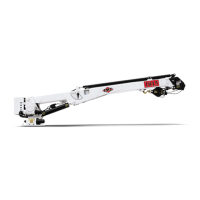99903514:TELESCOPIC CRANE:
2-14 SECTION 2: MAINTENANCE
2-11: CORROSION CONTROL
IMT treats metal to metal surfaces and hard-
ware on new cranes with Cortex VCI-389, a
chemical for rust prevention. Surfaces sprayed
with Cortex VCI-389 will have a slight yellow or
cream color. The discoloration can be removed
with a degreaser or citrus cleaner.
Cortex VCI-389 prevents rust for about one year
from application. It can be reapplied after crane
disassembly or cleaning for continued rust
prevention.
In addition, to ensure the life and appearance of
the crane, which includes booms, hydraulic
hoses, rotation bearings and rotation gearing,
the crane must be thoroughly washed and
lubricated after performing job functions in harsh
environments, such as dirt, sand, salt water
spray, etc. If this maintenance step is ne-
glected, you run the risk of shortening the life of
the crane through corrosion and abrasion. After
a thorough washing, refer to Figure B-2, Lubri-
cation Products & Schedule, for proper mainte-
nance as scheduled.
2-12: LONG TERM STORAGE
When a crane is put into long term storage, it
should be stored within a controlled environ-
ment. To prolong the life of hydraulic system
seals, o-rings, hoses, filters and pumps, the
crane must be operated and maintained on a
regular basis. If this maintenance is neglected,
hydraulic system components will dry out which
will require extensive repair and expense. IMT
recommends the crane be operated, with all
functions cycled fully as in normal operation, at
least every three months. The climate in which
the crane is stored may dictate more frequent
operation to prevent component deterioration.
All wire rope which has been idled for a period of
a month or more, due to shutdown or storage of
a machine, shall be given a thorough inspection
before it is placed into service. This inspection
should cover all types of deterioration.
2. HYDRAULIC PUMP
A. Check for leaks at shaft seal.
B. Check for drop in operating speed.
C. Check hydraulic oil for excessive
heating.
D. Check bolts and fasteners for tightness.
Note any unusual vibration or noise.
3. PTO AND PUMP
A. Inspect for proper transmission gear to
PTO engagement.
B. When supplied, inspect driveline U-joints
for securing cap tightness and adequate
lubrication.
C. Check mounting bolts on pump and
PTO for tightness.
2-10: TETHERED REMOTE CONTROL
INSPECTION
The tethered remote controls are subject to
corrosion. They must be checked at least twice
yearly and more often if operated in severe, wet
conditions. To check for corrosion:
1. Remove the cover of the control handle and
inspect for a lack of luster. Metal should appear
bright and untarnished.
2. Spray the inside of the control handle with
ignition sealer.
3. Check for broken or corroded ground wires,
normally attached to the chassis frame with a
self tapping screw. If faulty or extremely cor-
roded, clean thoroughly and replace using new
hardware.
WARNING
FAILURE TO COMPLY WITH THESE
INSTRUCTIONS MAY RESULT IN A CON-
TROL FAILING TO RETURN TO NEUTRAL
AND MAY CAUSE SERIOUS INJURY,
DEATH OR EQUIPMENT DAMAGE.
20030129

